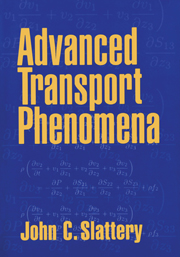Book contents
- Frontmatter
- Contents
- Preface
- List of Notation
- Advanced Transport Phenomena
- 1 Kinematics
- 2 Foundations for Momentum Transfer
- 3 Differential Balances in Momentum Transfer
- 4 Integral Averaging in Momentum Transfer
- 5 Foundations for Energy Transfer
- 6 Differential Balances in Energy Transfer
- 7 Integral Averaging in Energy Transfer
- 8 Foundations for Mass Transfer
- 9 Differential Balances in Mass Transfer
- 10 Integral Averaging in Mass Transfer
- A Tensor Analysis
- B More on the Transport Theorem
- References
- Author/Editor Index
- Index
9 - Differential Balances in Mass Transfer
Published online by Cambridge University Press: 05 June 2012
- Frontmatter
- Contents
- Preface
- List of Notation
- Advanced Transport Phenomena
- 1 Kinematics
- 2 Foundations for Momentum Transfer
- 3 Differential Balances in Momentum Transfer
- 4 Integral Averaging in Momentum Transfer
- 5 Foundations for Energy Transfer
- 6 Differential Balances in Energy Transfer
- 7 Integral Averaging in Energy Transfer
- 8 Foundations for Mass Transfer
- 9 Differential Balances in Mass Transfer
- 10 Integral Averaging in Mass Transfer
- A Tensor Analysis
- B More on the Transport Theorem
- References
- Author/Editor Index
- Index
Summary
This chapter parallels chapters 3 and 6. Although the applications are different, the approach is the same. One is better prepared to begin here after studying these earlier chapters.
There are three central questions that we will attempt to address.
When is there a complete analogy between energy and mass transfer?
When do energy and mass transfer problems take identical forms?
When is diffusion-induced convection important?
In the absence of forced convection or of natural convection resulting from a density gradient in a gravitational field, the convective terms are often neglected in the differential mass balance for species A with no explanation. Sometimes the qualitative argument is made that, since diffusion is a very slow process, the resulting diffusion-induced convection must certainly be negligible with respect to it. We hope that you will understand as a result of reading this chapter that this argument is too simplistic. Under certain circumstances, diffusion-induced convection is a major feature of the problem. Sometimes we are able to show that diffusion-induced convection is identically zero. More generally, diffusioninduced convection can be neglected with respect to diffusion as equilibrium is approached in the limit of dilute solutions.
When must we describe diffusion in multicomponent systems as multicomponent diffusion? We already know the answer from Section 8.4.6: in concentrated solutions. In this chapter, we will try to get a better feeling for just how concentrated the solution must be before the approach using binary diffusion fails.
- Type
- Chapter
- Information
- Advanced Transport Phenomena , pp. 482 - 572Publisher: Cambridge University PressPrint publication year: 1999



